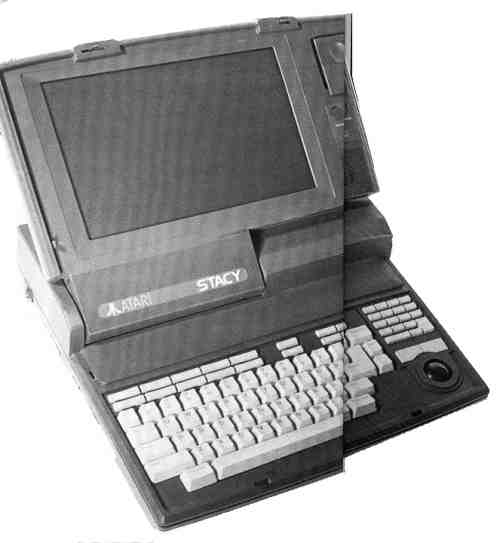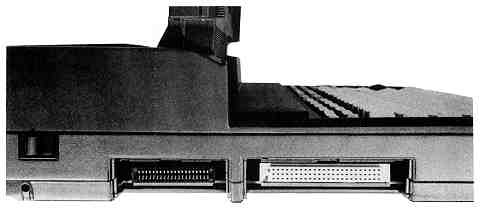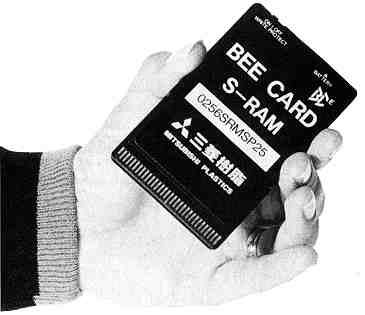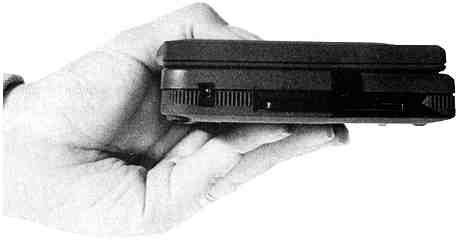BY ANDREW REESE START EDITOR
Hands-On Preview of Atari's STACY and Portfolio
Picture, if you will, two businesspeople sitting in an airport waiting room. Each is using a portable computer to catch up on business. One computer is a classic-looking, charcoal-gray laptop and the other a miniscule hand-held. You've just entered. . . the Atari Zone. Read on for a hands-on evaluation of Atari's newest computers: the STACY and Portfolio.

STACY's keyboard layout
is extremely usable in little space. The function keys,
cursor group and keypad
have been relocated and reduced in size, but they are
at least as usable as
the ST's, if not better. And the keyboard itself is full-sized
and a pleasure to use,
much better even than a Mega.

The Portfolio's keyboard
is too small to do much in the way of touch typing. The keys are
uniquely shaped, square
with the upper left-hand corner removed. At their lower edges,
they're flush with the
surface of the keyboard, while at the upper edge, they protrude just
over 1/16-inch.
Atari has seemed to be dormant in the marketplace during the last year. Now, with Fall of 1989 upon us, the sleeping giant has awakened. Poised for a strong fourth quarter, Atari is bringing to market a series of spectacular new computers. First on dealers' shelves is the Portfolio, the hand held MS-DOS computer developed by DIP in England. Coming on its heels is the release of STACY, the Long-awaited ST laptop. By the time you read this, both computers should be available through Atari dealers across the country.
We were fortunate to spend some time with both computers. The STACY and Portfolio are very different from each other, but each is special in its own right. Both bear the handsome new Atari charcoal-gray color and both promise computing power for the user on the run. We'll start with a look at STACY and then move on to Portfolio.
STACY
I'm beginning this article on one of the
STACY prototypes in a conference room in Atari's home office in Sunnyvale,
California. It's not the final production version, but it's in near-final
form and close enough to evaluate it as a computer and, well, as a computing
experience.
insert a disk and turn on the computer.
STACY is, as you can see from the photos accompanying this article, clad in a handsome, sculptured charcoal-gray case designed by Atari's Ira Velinsky. It has a bright, backlit supertwist LCD screen and a golf-ball-sized trackball in place of the standard Atari mouse. Inside, it's almost a straight 1040ST, complete with all of the ports you're familiar with from your own ST or Mega.
Specifically, STACY has the following ports: Centronics parallel, serial, DMA, mouse/joystick, joystick, MIDI in and out, monitor and floppy disk drive. In addition, STACY has a special power jack, so that it can be operated from a battery-saving wall external power supply. Finally, STACY has a special bus port with the same connections as the internal Mega bus port; the pin-outs are different from the Mega plug, but electrically, it's the same. This means that any bus-port device now existing for the Mega, such as the Moniterm big-screen monitor interface or JRI's GenLock, could be made to work with STACY.
Like most laptops, STACY's screen acts as a cover for the keyboard and pivots up for use. The power switch is on the left-rear side as you're facing the keyboard and the disk drive(s) are on the right side (This prototype was equipped with two internal double-sided drives, stacked one over the other. STACY will be available initially equipped with a single DS drive. It will also be available later with your choice of two floppy drives or one floppy and a 20-Megabyte internal hard disk.)

Floppy disk access is
from STACY's right side. This particular unit was equipped with double-sided
drives, although the standard
configuration is with one floppy drive. A hard drive will take the place
of one of the floppy drives. The access
door toward the front covers the standard mouse and joystick ports.
And on to Business
The production external power supply was not available for our tests,
so we used a Hewlett-Packard lab supply to supplement STACY's internal
battery supply. STACY's internal batteries are in a compartment at the
top of the case near the screen pivot. Details as to whether the batteries
are recharged in place automatically were not available at this time. The
battery pack is removable, so conceivably they could be recharged away
from the unit.
Booting STACY is just like booting any ST: insert a disk and turn on the computer. I tried booting with my normal complement of accessories and TSR programs, including G+Plus, UIS II, ReSTART, HotWire and Turbo ST. Everything worked perfecdy.
I then tried booting Spectre 128. It too worked perfectly and after a moment I was looking at the first Macintosh laptop in captivity. If you have been wanting one of Apple's long-delayed laptops, save yourself time and money and try this combination.
I also tried pc-ditto, Flash! and Cyber Sculpt to see if there were any differences in operation between STACY and an ST. None. It acts exactly like what it is: a portable 1040ST.
The Feel of a Rolls-Royce
Atari has done a magnificent job with STACY's keyboard. The key spacing
and feel is as good as the best IBM add-on keyboard you can buy. There's
a nice, positive over-center feel and a solid rebound that lets you know
when you have keyed in a character. I made fewer inadvertant keypresses
on the STACY keyboard than I normally do on my ST or Mega.
The location and size of the cursor arrows take some getting used to. They're located further up in relation to the keyboard than on an ST. The [Help] and [Undo] keys have also been repositioned and are to the left of the cursor keys instead of above them.
The keypad is quite small and appears awkward, but the keys are contoured along their width- cupped- to avoid double hits. Once you're properly located on the keypad, you won't miss a key. I do wish, however, that Atari would add a bump to the [5] key to make it easy to find.
Atari has included a unique golf-ball-sized trackball with two buttons above it on the right side of the keyboard. For a right-hander, it's well located, but southpaws may complain. You can always plug in a mouse if you're using STACY on a desk; it won't work on your lap, however.
One question I wanted to answer was how easy the STACY trackball was to use. I was pleasantly surprised. It does take some getting used to, but its small size and convenient buttons are easier to use than others available for the ST. Cursor movement seems more proportional and controllable
like what it is: a
portable 1040ST.
The function keys are smaller than on the ST and stacked [Fl] through [F5] in one row above [F6] through [F10]. I expected to have trouble with them because of their size, but surprisingly, they're easier to use than the STs slanted buttons that always seem to confuse my fingers. It's easy to hit the right function key on STACY.
The Look
STACY has a backlit supertwist LCD screen, meaning that the display
is visible with no external light and retains good contrast in almost any
lighting situation. It mimics the ST monochrome screen and has a full 640-by-480
pixels in a 53/4-inch-by-9-inch display. Under the display in bold letters
is the logo ATARI STACY. (According to Atari, this is the official name:
STACY, all in capital letters.)
To the right of the display is a clip that does double duty. It has a light spring pressure to keep a tension on the trackball when the lid is closed, and while you're using STACY, it acts as a document clip to hold papers next to the screen. Clever.
Below the spring clip is the volume control for the built-in speaker and a contrast control. Below that are three indicators, two for the disk drives and the third for the battery. They are labeled FDD A (Floppy Disk Drive A), FDD B/HDD (Floppy Disk Drive B/Hard Disk Drive) and BATT. The drive lights are the same "drive busy" lights we're used to on the ST.
I found that the screen retained its visibility well and I was always able to position it so that the screen had good contrast. One problem I noted was that even though the cursor arrow is the same size as that on the ST, it seemed less visible. I had a hard time finding it until I moved it. I was not able to determine whether that's because of a change in the cursor mask or just inherent in an LCD display.
Remember that this was an engineering prototype, rather than a production STACY. Atari promises that the production STACY will have an even better display. Even as it is, it's eminently usable, if not as striking as some of the red-on-black displays on the higher priced IBM-compatible units.

STACY has all of the
ports you've become used to on the ST. From left to right across the back
are the
serial, parallel, external
floppy disk drive, DMA, external monitor, MIDI ports and the external power
source socket with the
reset button adjacent to it.
Laptop Use
This is not a miniature computer, like the Portfolio. It has a full-size
keyboard, plus the added width for the trackball and keypad, yet it fit
comfortably on my lap and I was able to position the screen for a good,
bright display.
One problem is that a great deal of the weight of STACY is concentrated at the back of the machine, from the screen pivot back. The battery pack and the disk drives are all located there and when you swing the screen back enough to get a good viewing angle, its weight is added. I found that it tended to be a bit heavy on the knees and light on the thighs. Of course, it will fit everyone differently, depending on height, chair height and so on.
Is STACY for You?
STACY is an interesting computer. It is a 1040ST with a better keyboard
in a convenient package, complete with all of the ST's ports. It is set
to retail at $1,499 for a single drive model, a healthy premium over the
equivalent monochrome desktop 1040ST. If you are one of the thousands of
people who have been waiting for a laptop ST, Atari did a good job realizing
STACY; you won't be disappointed. If you type a lot, you might want to
consider STACY for its superior keyboard, even if you set it up on a desk
with an external monitor and power supply.
For those waiting for a multi-purpose laptop computer STACY fills the bill nicely. With pc-ditto and Spectre, you can have a "three-headed monster" that can run almost any software out there anywhere I was unable to determine if the new pc-ditto II would fit inside STACY- that question will have to wait for a later report for an answer, but cartridge-based Spectre GCR should work splendidly.
STACY, I was looking
at the first Macintosh
laptop in captivity.
For those of us who commute on public transportation and use an ST at work, STACY looks like a godsend. I'm looking forward to the experience.
Atari has set the roll-out of STACY for September 1, so that by the time you read this, you should be able to run (don't walk) to your local Atari dealer and check out STACY for yourself. It's well worth a 'look.

STACY's left side. Closest
to the front is the bus port, next is the cartridge port
and at the back is the
power switch. STACY's internal batteries are in a
compartment at the top
of the case near the screen pivot.
Portfolio
It's a jewel, a tiny MS-DOS computer that
charms everyone who sees it. It's Atari's Portfolio and it should be available
in Atari dealers by the time you read this for the unbelievable price of
$399.
When Atari says that the Portfolio is the size of a VHS VCR tape, they're right. It's the same width and thickness and 1/4-inch longer When you pop the lid, amazingly, there's a full QWERTY keyboard with additional keys for special functions.
I had the pleasure of spending five days with Portfolio at the start of July. I've played around with the Sharp Wizard and several other of the hand-held life organizers on the market and thought that the Portfolio was in the same league. In fact, it does much of what its anemic competitor does, but it's more-so much more.
To begin with, the Portfolio runs a clone of MS-DOS 2.11; that means that you can run almost any software from the IBM world. You can easily port files and software in either direction to or from your IBM-style hardware. And because the Portfolio port can be software configured to be either a Centronics parallel printer port or a 9600-baud serial port, you can pass files back and forth to any other brand of computer as well.
Did you pick up on the fact that the Portfolio can be configured with a printer port? Yes, you can connect the Portfolio to a parallel printer and print from the built-in software or from any other MSDOS software you run.
Another aspect of the Portfolio that separates it from the crowd is its memory. For the base price, you get 128K of RAM and 256K of ROM. All of the operating system is in ROM - no disk accesses to run MS-DOS! The balance of the ROMs is taken up by an ASCII text editor complete with clipboard, search-and-replace and word wrap, a Lotus 1-2-3-compatible spreadsheet with 127 columns and 255 rows, a powerful calculator a diary with notes and alarms and an address book. All of the programs have their own online help, keyboard equivalences and- also built-in-you can switch among English, French and German menus and help!
Atari has also included a RAM card reader in the Portfolio. The credit card-sized RAM cards slip into the reader on left end of the Portfolio. It's recognized as Drive A and cards will he available with battery-backed storage of up to 128K.
Finally Atari is making the Portfolio expandable You will be able to add external "daisy chain" modules on the port on the right end of the unit to expand the internal RAM to up to 640K and then add the printer port, serial port or even an external RAM-card reader to the end of the chain. (There's even going to he a RAM-card drive for IBM compatibles to make "disk" transfer of files and programs easy) Take that. Sharp!
The Lilliputian National Computer
The Portfolio is the first of several hand-held computers due out in
1989-and will have the best price. But can you actually use a computer
this size? The answer is a resounding "Yes!"
Because the peripherals were not available at the time I tested the Portfolio, I cant report at this time on MS-DOS software running on this tiny wonder. I did, however try out all of the built-in software and experiment with all of the DOS commands.
One of the First things I did was to write a new AUTOEXEC.BAT file. Most of the familiar commands worked just like they do on Portfolio's bigger cousins. There are several special MS-DOS and .BAT commands peculiar to the Portfolio. For example, typing "off" at a prompt turns the unit off. (You can also turn it off by holding down the [Fn]-Function -key and pressing the [O] key or just by not pressing a key for a few minutes.) And in a .BAT file, the command "app" brings up the built-in applications menu.
Copy, delete, makedir, removedir and dir[ectory] commands all work just as they do on IBM hardware, complete with "/" commands appended and wildcards. The .BAT commands allow IF and branching structures to let you customize your installation.
There are no function keys on the Portfolio as such; the number keys double as the function keys when you hold down the [Fn] key. To bring up the key menu in each application, you need only touch the Atari logo key-the Fl menu appears over the application immediately. Then you can move up and down the menu with the cursor keys or just touch the keyboard equivalent of the menu item (its first letter) and a second menu appears. It's all very well thought out and implemented.
To select an item from a menu, you just touch the [Return] key. To back out of an item or application, you just touch the [Esc] key. A touch of the [Esc] key from the Applications menu takes you back to the DOS prompt. Its that easy.
Firing It Up
The Portfolio comes with a Quick Reference Card (which I didn't see)
and a pretty-well-written 237-page manual (with no index) that explains
the basics of DOS and all of the built-in software. If you have some familiarity
with DOS, you'll appreciate the manual more, since it jumps into DOS commands
and CONFIG.SYS and AUTOEXEC.BAT files almost immediately. It might have
been better to include a "quick start" for neophyte users at the start
and then delve into the mysteries of DOS in a later chapter. It looks a
bit intimidating as it is.
I hope that the first thing the Quick Reference Card tells users is how to type in "app" at the DOS prompt to reach the applications menu. Once there, non-computer users can feel insulated from those aspects of computers that frighten them in the first place. If I were a neophyte who bought a Portfolio in preference to a Sharp Wizard, for example, and then was confronted with MS-DOS for most of the first 50-plus pages of the manual, I think I'd close the lid, close the manual and look for something easier to master.
The Portfolio gives approximately 20 hours of use on three AA pencell batteries. Alkaline batteries are recommended; since rechargeable NiCad batteries have a nominal voltage of 1.2 volts rather than the 1 5 volts of dry cells or alkaline cells. I suspect that you can't use rechargeables in the Portfolio. The manual says nothing about it.
Once you insert the three batteries, you turn on the Portfolio by touching any key on the keyboard. Up pops an MS-DOS prompt on the Portfolio's built-in supertwist eight-line by 40-character display. The Portfolio operating system automatically sets up a RAM disk of one-fourth of the available RAM at startup and maintains this memory even while the computer is off or while you're changing batteries. You can reconfigure this RAM disk, but doing so will wipe out all of the files on it.
The RAM card can be inserted or removed at any time, except during those brief periods of disk access. If you direct the Portfolio to read the A: drive with no RAM card in the slot, you get the familiar MS-DOS prompt: "Abort, Retry, Ignore?"
Touch Typing, Anyone?
The Portfolio's keyboard is small, too small to do much in the way
of touch-typing unless you're eight years old or less. It works better
for a hunt-and-peck typist or, as my wife observed, for thumb typists.
The keys are uniquely shaped, square with the upper left-hand corner removed.
At their lower edges, they're flush with the surface of the keyboard, while
at the upper edge, they protrude just over 1/16-inch. Between those two
points, the keys are convex, bulging out toward the fingers. They're surprisingly
usable and the 1/16-inch-plus rise helps your fingers locate the rows easily.

In place of a disk drive,
the Portfolio uses battery-backed
Static RAM (SRAM) cards
in configurations up to 128 k.
They're approximately
the size of a credit card.
For any adult used to an Atari ST keyboard, the Portfolio takes some getting used to. It took me a few hours to feel comfortable with the key locations and keystroke combinations. After that, I found that I could accomplish what I wanted with a minimum of fuss, typing in text, creating a spreadsheet, adding names to the address book, entering calendar notes and setting alarms easily.
Unfortunately, we don't have space to review each of the Portfolio's built-in applications in this issue. Suffice it to say that they are adequate, well-designed and intuitive in their operation. And there's always online help two keystrokes away.
Final Thoughts
The Portfolio should make Atari millions of dollars and make the Atari
name a familiar one in corporate offices around the world, its MS-DOS compatibility
almost guarantees instant success and its impressive and friendly design
should produce wide acceptance by the general public. Is it for you? Do
you need a small computer to do your work on the run? Do you need a combination
address book, notebook, calendar calculator and spreadsheet that fits in
an inside suitcoat pocket? Only you can answer that question, but I can
tell you that the Portfolio is the computer sensation of 1989. Be sure
to look at it at your Atari dealer.

On the left end of the
Portfolio is an SRAM Card "drive," accessed as Drive A
by the operating system.
You can Insert or remove SRAM Cards at any time,
except when the system
is accessing them-just like a floppy disk. Also visible
is the external power
jack at the left.